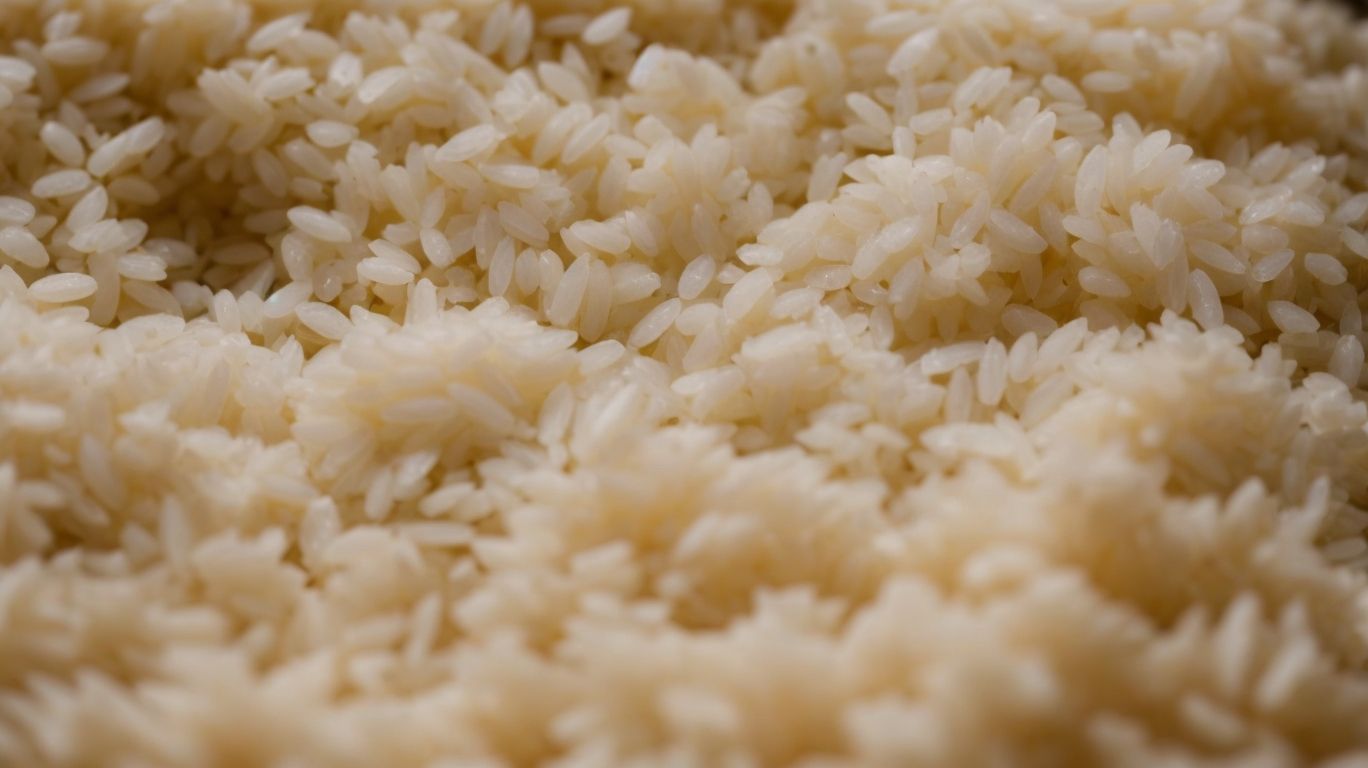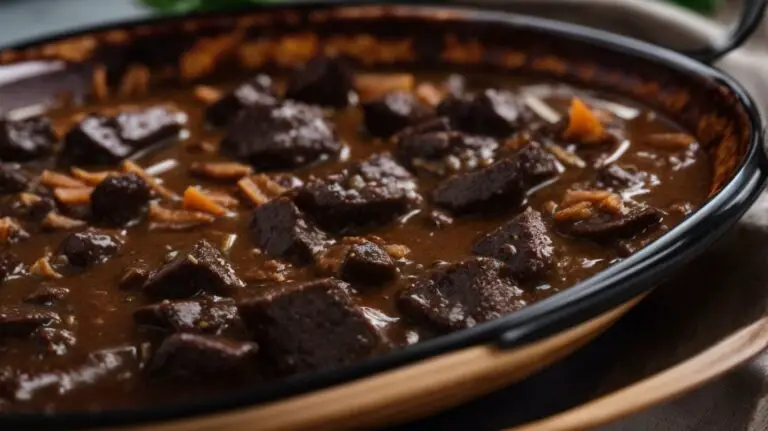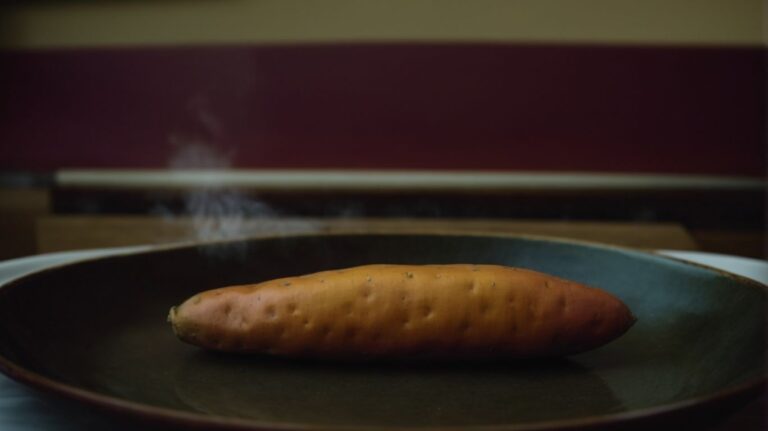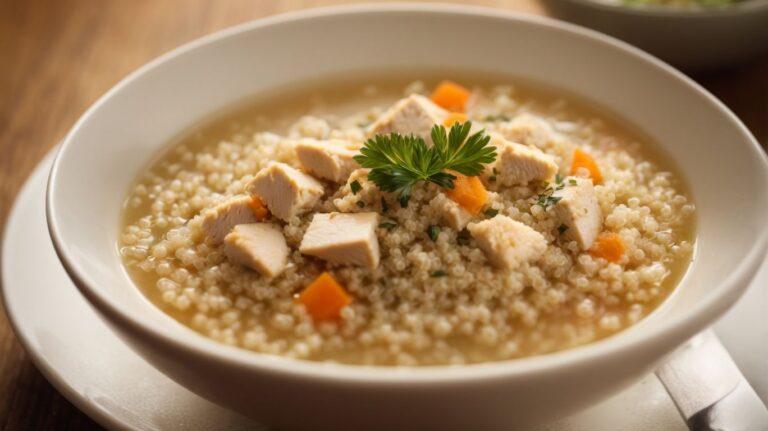How to Cook Japanese Rice for Fried Rice?
Are you a fan of Japanese cuisine and looking to replicate the authentic flavors at home? Look no further!
We will explore what sets Japanese rice apart, the key ingredients for making delicious Japanese fried rice, and step-by-step instructions on how to cook Japanese rice perfectly for your fried rice dish.
From rinsing the rice to combining the ingredients and seasonings, we’ve got you covered. Get ready to elevate your cooking game with these tips and tricks!
Key Takeaways:
What Makes Japanese Rice Different?
Japanese rice stands out due to its unique characteristics, setting it apart from other varieties. Notably, the short grain rice used in Japanese cuisine plays a crucial role in defining the texture and flavor of traditional dishes.
This type of rice, known for its high starch content, is responsible for creating the sticky and chewy consistency so prevalent in Japanese dishes like Yakimeshi.
When cooked, the starch in short grain rice releases a viscous substance that binds the grains together, resulting in the desired cohesive texture. The sticky nature of this rice variety is ideal for dishes where the rice needs to hold together well, such as sushi or rice balls.
Short Grain Rice
Short grain rice, a staple in Japanese cuisine, is characterized by its plump and rounded grains that have a higher starch content compared to long grain varieties.
This high starch content gives short grain rice its signature sticky texture when cooked, making it ideal for dishes like sushi where the grains need to hold together firmly. The texture of short grain rice is essential in creating traditional Japanese rice dishes such as Japanese fried rice, where the slightly chewy consistency adds a delightful contrast to the dish.
Starch Content
The starch content of Japanese rice, particularly in short grain varieties, contributes to the sticky and chewy consistency prized in dishes like Yakimeshi, enhancing the overall dining experience.
Japanese rice, known for its high starch content, is a staple ingredient in a variety of traditional dishes. The starch content determines the stickiness of the rice, a key factor in creating the perfect texture for dishes like sushi. When the rice is cooked, the starches gelatinize, giving the rice its characteristic chewiness.
For Japanese fried rice, the starch content helps the grains stick together without turning mushy, resulting in a delightful texture that complements the flavors of the dish. In sushi preparation, the right balance of starch is crucial to ensure that the rice holds its shape when molded into sushi rolls.
What Are The Ingredients For Japanese Fried Rice?
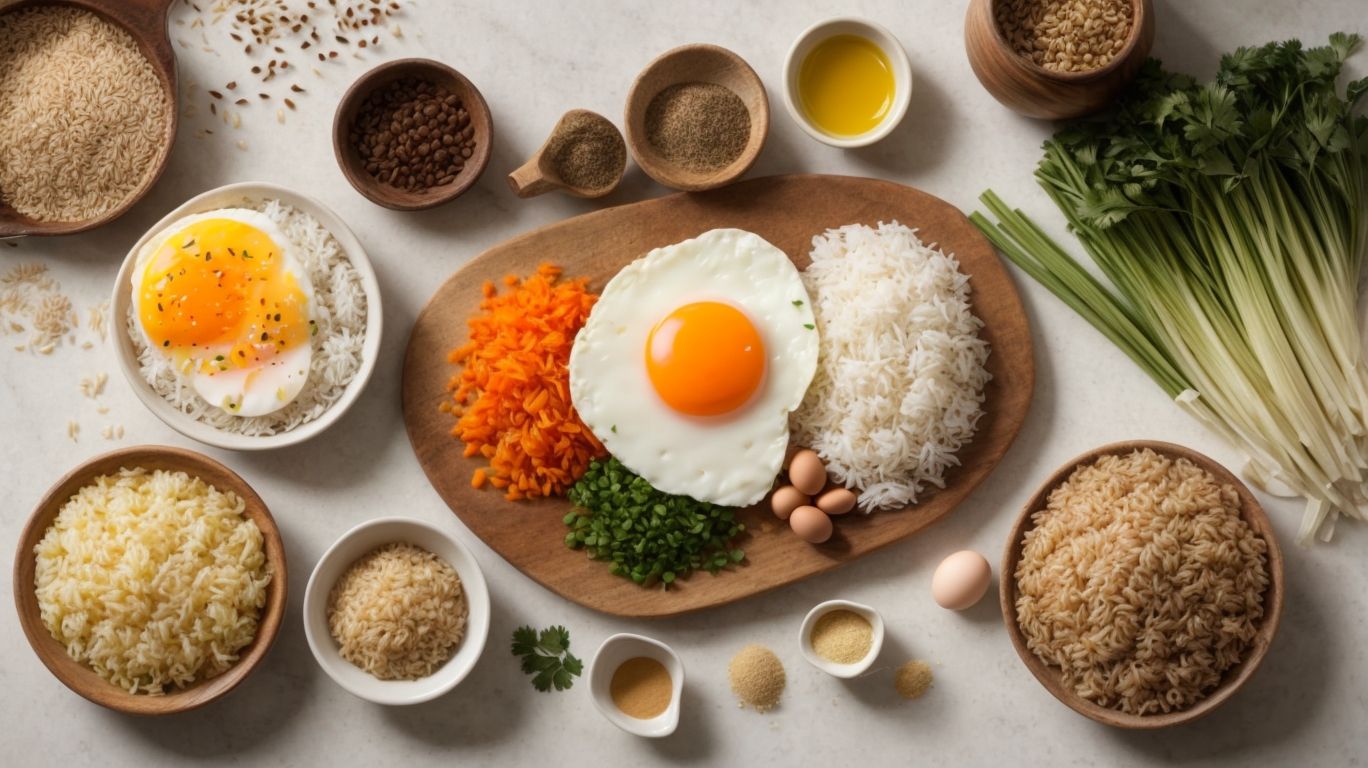
Credits: Poormet.Com – Samuel Green
Japanese Fried Rice, known as Yakimeshi, relies on a harmonious blend of ingredients such as eggs, vegetables, proteins, and soy sauce to create a flavorful and satisfying dish.
Each component plays a crucial role in defining the distinct taste and texture of this beloved Asian dish. Eggs add a rich and creamy element, binding all the elements together. Colorful vegetables not only bring freshness but also provide a delightful crunch to every bite. Proteins like chicken, pork, or shrimp introduce depth of flavor, while soy sauce infuses the dish with that signature umami essence.
Short Grain Rice
Short grain rice, a fundamental ingredient in Japanese Fried Rice, serves as the base that absorbs flavors and aromas while providing the signature chewy texture to the dish.
Japanese Fried Rice, known as ‘Chahan’ in Japan, showcases the essence of Japanese culinary tradition through the delicate handling of short grain rice.
This variety of rice, known for its innate stickiness and ability to hold moisture, is essential in achieving the desired consistency and mouthfeel in the dish.
The unique starch composition of short grain rice, characterized by higher amylopectin content, allows it to achieve a tender yet firm texture when cooked, elevating the overall eating experience.
Its ability to absorb seasonings and flavors fully enhances the umami-rich profile that is synonymous with authentic Japanese cuisine.
Vegetables
Fresh and vibrant vegetables play a vital role in Japanese Fried Rice, adding color, nutrients, and a delightful crunch to the dish.
When selecting vegetables for Yakimeshi, freshness is key to ensuring the flavors pop in every bite. Common choices include carrots, peas, bell peppers, and onions. Carrots bring a natural sweetness, peas offer a burst of freshness, bell peppers introduce a slightly tangy note, while onions provide a savory depth. Each vegetable contributes a different texture and taste, creating a harmonious blend in the dish. Ahead of cooking, ensure to dice or julienne the vegetables uniformly to guarantee even cooking and a visually appealing presentation.
Protein
Proteins such as chicken, pork, or shrimp are commonly used in Japanese Fried Rice to add richness, depth, and a savory element to the dish.
These protein sources play a vital role in not only providing essential nutrients but also elevating the overall flavor profile of Yakimeshi.
- Chicken, with its tender texture and mild taste, brings a comforting familiarity to the dish.
- The succulent pork adds a savory depth that complements the umami flavors.
- Shrimp introduces a light seafood essence that adds a delicate touch to the fried rice.
By incorporating protein-rich ingredients, the dish becomes not only more satisfying but also nutritionally balanced.
Seasonings
Seasonings like soy sauce, garlic, and a touch of salt and pepper are essential in elevating the flavors of Japanese Fried Rice, creating a harmonious blend of savory notes.
Japanese Fried Rice, also known as Yakimeshi, derives its unique taste from the careful selection and precise combination of various seasonings. Soy sauce, a fundamental ingredient in Yakimeshi, not only adds depth and richness but also contributes to the iconic umami flavor that characterizes Japanese cuisine. The umami factor is further amplified by the pungent aroma of fresh garlic, another essential seasoning in this dish.
When these seasonings are skillfully balanced, they work in harmony to create a dish that is both flavorful and aromatic. The soy sauce provides a salty and slightly sweet profile, while the garlic infuses a subtle yet distinct garlicky essence that lingers on the palate.
How To Cook Japanese Rice?
Preparing Japanese rice involves specific steps to ensure the perfect texture and consistency that are integral to traditional Japanese cuisine.
One crucial step in preparing Japanese rice is rinsing. Start by gently rinsing the rice under cold water to remove excess starch, which can cause the rice to be sticky. This process helps achieve the desired fluffy and separate grains in the cooked rice.
Regarding water measurement, the ideal ratio for cooking Japanese rice is important. Typically, the ratio is 1:1 for short-grain rice and 1:1.1 for medium-grain rice. This precise measurement ensures that the rice cooks evenly and has the proper moisture content.
After rinsing, soaking the rice for about 30 minutes before cooking is recommended. This step allows the grains to absorb moisture evenly, resulting in a more consistent texture and better flavor.
When cooking the rice, using a heavy-bottomed pot with a tight-fitting lid is essential. Simmer the rice over low heat to allow it to cook gently and avoid scorching the bottom. Stirring the rice during cooking can release excess starch and lead to a stickier end result.
Once the rice is cooked, let it rest off the heat for about 10 minutes. This resting period is crucial for allowing the steam to redistribute evenly throughout the rice, resulting in perfectly cooked grains that are neither too wet nor too dry.
Rinse the Rice
Rinsing Japanese rice before cooking is a crucial step to remove excess starch and achieve the desired fluffy texture in the final dish.
When preparing Japanese rice, rinsing plays a fundamental role in its cooking process. The primary reason for rinsing is to eliminate the surface starch present on the grains. This starch can lead to a stickier and clumpier consistency if not rinsed off properly. By rinsing the rice, you ensure that it cooks evenly and becomes light and fluffy.
There are various methods for rinsing Japanese rice, including the traditional washing technique where you fill the bowl with water, gently agitate the rice, and pour off the cloudy water. Alternatively, some opt for the soaking method, allowing the rice to sit in water for a few minutes before rinsing.
Measure the Water
Correctly measuring the water-to-rice ratio is essential when cooking Japanese rice to achieve the ideal balance of moisture and fluffiness.
Japanese rice, also known as ‘Japonica’ or ‘Sushi rice’, demands precise water measurement for a perfect outcome. The typical ratio for cooking Japanese short-grain rice is 1:1.1 – for every cup of rice, add 1.1 cups of water. This ratio ensures a slightly sticky and chewy texture, which is favored in many Japanese dishes. If you prefer a firmer or softer consistency, you can adjust the water levels.
For a firmer texture, reduce the water slightly. On the contrary, if you desire a softer, stickier rice, increase the water amount. It’s important to consider the rice type and personal preferences while determining the water measurement, as different varieties may require slight variations in ratios.
Soak the Rice
Soaking Japanese rice before cooking helps the grains absorb water evenly, promoting uniform cooking and a consistent texture in the final dish.
When you soak Japanese rice, you allow the grains to soften, leading to a more tender and fluffy outcome. This process also reduces the overall cooking time as the softened rice cooks faster and more evenly. One key advantage of soaking is that it enhances the flavor by unlocking the natural sweetness of the rice. Soaking helps to remove excess starch from the grains, preventing them from becoming sticky or clumpy.
For optimal results, it is recommended to soak the rice for at least 30 minutes to an hour before cooking. Some chefs prefer soaking for up to 4 hours or even overnight for a deeper infusion of moisture and flavor. The different soaking methods, such as cold water soaking, hot water soaking, or quick soaking techniques, can also impact the rice’s texture and taste, offering versatility in preparation based on personal preferences.
Cook the Rice
Cooking Japanese rice using the absorption method or a rice cooker ensures a fluffy and perfectly cooked result that aligns with traditional Japanese culinary standards.
The absorption method entails carefully measuring the water-to-rice ratio and allowing the rice to simmer until each grain has absorbed just the right amount of liquid. This technique requires precision and attention to detail, reflecting the meticulous nature of Japanese cuisine.
On the other hand, rice cookers offer convenience and consistency by automating the cooking process. These modern appliances use advanced technology to regulate temperature and timing, producing reliable results every time.
Traditional Japanese cooking practices emphasize the balance of flavors, textures, and presentation, with rice playing a central role in many dishes. Achieving the desired light and fluffy texture is crucial for the overall harmony of the meal.
Let it Rest
Allowing Japanese rice to rest off the heat after cooking enables it to absorb any remaining moisture and steam, enhancing its texture and overall quality.
During the resting process, the residual heat continues to gently cook the rice, ensuring that each grain is perfectly tender and not overcooked. This phase also plays a crucial role in allowing the flavors of the rice to fully develop. As the rice absorbs the steam within, it becomes more cohesive and less likely to clump. This essential step ensures that the rice is not only well-cooked but also has the ideal balance of moisture content, resulting in a satisfyingly delicious bowl of Japanese rice.
How To Make Japanese Fried Rice?
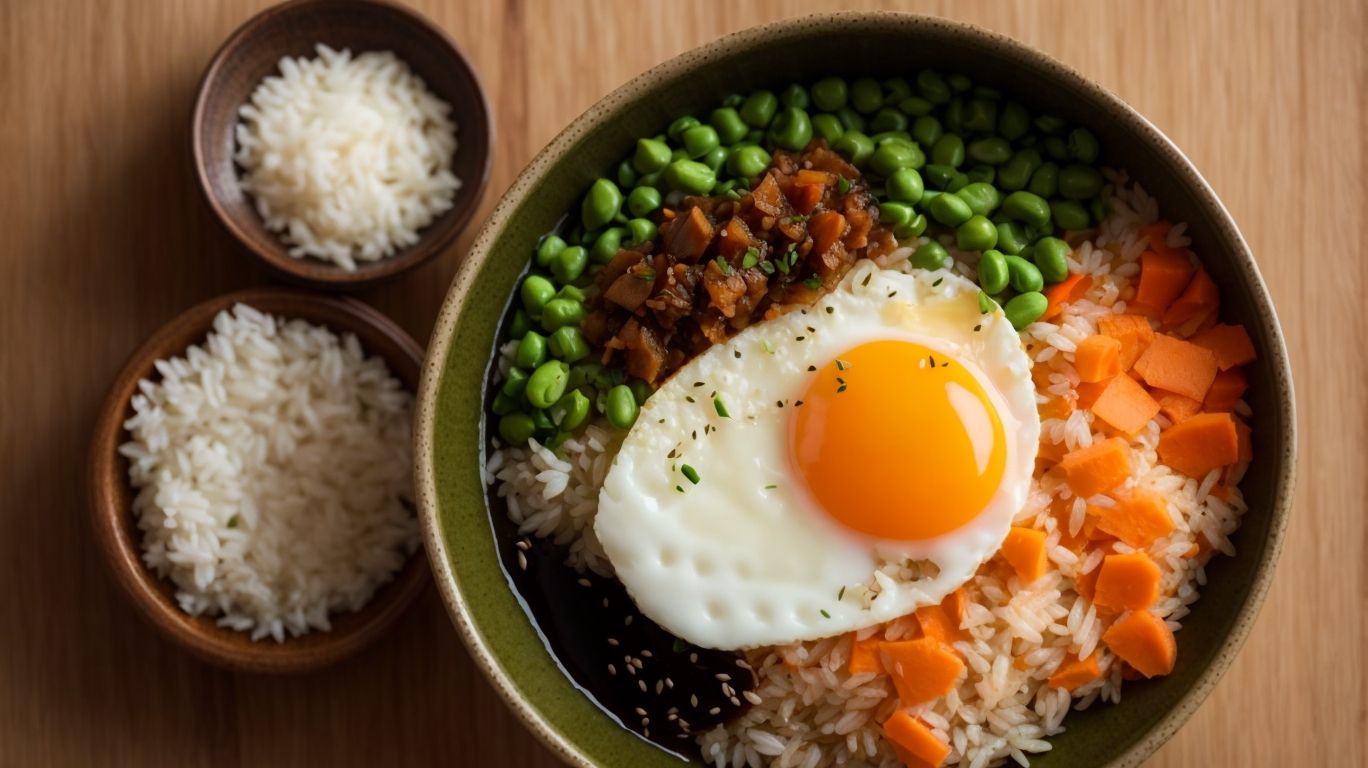
Credits: Poormet.Com – Ralph Wright
Crafting Japanese Fried Rice, known as Yakimeshi, involves a series of precise steps that combine ingredients and seasonings to create a dish bursting with umami and savory flavors.
To start the journey of preparing this delectable dish, begin by gathering the essential components:
- cooked rice
- vegetables such as onions, carrots, and peas
- protein like chicken, shrimp, or tofu
- eggs
- soy sauce
- sesame oil
It’s crucial to have all these ingredients prepped and ready as the cooking process for Yakimeshi is swift and demands timely execution.
Prepare the Ingredients
Gathering and preparing the ingredients for Japanese Fried Rice is a crucial step in ensuring a seamless cooking process and a harmonious blend of flavors in the final dish.
Quality ingredients play a significant role in elevating the taste of Yakimeshi. Fresh vegetables like carrots, peas, and green onions not only add color and texture but also infuse a vibrant flavor. High-grade soy sauce and sesame oil contribute authentic umami notes while eggs provide a rich, creamy element. The key lies in meticulous preparation – finely chopping vegetables, pre-cooking rice for optimal texture, and seasoning ingredients thoughtfully. By paying attention to these details, you can create a tantalizing Japanese Fried Rice that captures the essence of Yakimeshi.
Cook the Rice
Cooking the rice to perfection is a critical step in making Japanese Fried Rice, as it forms the foundation of the dish’s texture and flavor profile.
To achieve the ideal texture for your Yakimeshi, start by rinsing the rice thoroughly until the water runs clear. This removes excess starch that can cause the rice to become sticky.
Next, use the appropriate water-to-rice ratio, typically 1:1 for short-grain rice, for the perfect balance of moisture. When cooking, ensure the heat is maintained at a gentle simmer to prevent the rice from becoming mushy.
Stirring the rice occasionally during cooking helps distribute the heat evenly, resulting in uniformly cooked grains.
Cook the Vegetables and Protein
Sautéing the vegetables and protein components for Japanese Fried Rice adds depth and complexity to the dish, enhancing its nutritional value and overall appeal.
When preparing Yakimeshi, it is crucial to start with a hot pan and oil to ensure a proper sear on the ingredients. This initial step helps lock in flavors and create a caramelized exterior on the vegetables and protein. For optimal texture, it is recommended to chop the vegetables uniformly to promote even cooking. Incorporating soy sauce and mirin during the cooking process adds a savory and slightly sweet undertone that is characteristic of Japanese cuisine.
Combine Everything
Bringing together the cooked rice, vegetables, and protein in Japanese Fried Rice requires a delicate balance of flavors and textures to create a cohesive and satisfying dish.
To achieve the perfect Yakimeshi, the key lies in the art of combining these ingredients in a way that lets each component shine while harmonizing with the others. Regarding mixing, gently fold the rice with the seasoned vegetables and protein, ensuring that every grain is coated with the flavors. This process helps in evenly distributing the aromatics and seasonings, resulting in a more well-rounded and flavorful dish. Each step in the preparation contributes to the overall balance of textures and tastes, creating a delightful symphony of flavors in every bite.
Season and Serve
Seasoning Japanese Fried Rice with the right mix of sauces and spices elevates the dish’s flavors, while garnishing and presenting it beautifully enhances the overall dining experience.
Once the Japanese Fried Rice is perfectly seasoned, the final steps involve adding aromatic toppings like chopped green onions or fragrant sesame seeds to enhance the dish’s visual appeal. Garnishing techniques such as creating attractive patterns with colorful bell pepper slices or placing delicate edible flowers can add a touch of elegance to the dish. Remember, the way you present your Yakimeshi plays a crucial role in creating an aesthetically pleasing dish. Utilizing traditional Japanese serving dishes or arranging the rice in a visually appealing manner on the plate can make a significant difference in the overall dining experience.
Frequently Asked Questions
What is the best type of rice to use for fried rice?
The best type of rice to use for fried rice is short-grain Japanese rice. It has the perfect texture and stickiness to create delicious fried rice.
Why is it important to wash Japanese rice before cooking?
Washing Japanese rice removes excess starch and makes the rice less sticky, allowing it to absorb water more evenly during cooking, resulting in perfectly cooked rice for fried rice.
What is the ratio of rice to water when cooking Japanese rice for fried rice?
The general rule is to use 1 cup of rice to 1.2 cups of water. However, this ratio may vary depending on the type and quality of rice, so it’s best to follow the instructions on the rice package or experiment with different ratios to find the perfect texture for your fried rice.
Can I use leftover rice to make fried rice?
Yes, leftover rice is actually preferred for fried rice as it has a drier texture compared to freshly cooked rice, making it easier to stir-fry without becoming mushy.
Do I need a rice cooker to cook Japanese rice for fried rice?
No, you can cook Japanese rice on the stovetop using a pot or saucepan. However, a rice cooker may make the process easier and more convenient.
How do I prevent my fried rice from turning out mushy?
To prevent your fried rice from turning out mushy, use cold leftover rice and make sure to stir-fry it in high heat. This will prevent the rice from becoming too moist and sticking together.

